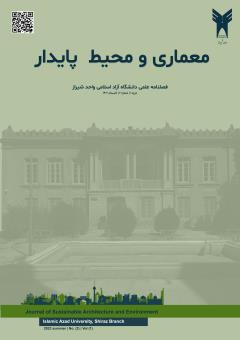Evaluation of the effects of the components of the behavior settings in increasing the creativity of the students of architecture schools in Shiraz, case study :(Shiraz Azad University, Shiraz Non-profit Institute of Art, Shiraz Eram Non-profit Institute)
Subject Areas : َArchitecturesara jowkar 1 * , Masoume Sazandeh 2
1 - ندارد
2 - Assistant Professor, Department of Architecture, Zarghan Branch, Islamic Azad University , Zarghan , Iran
Keywords: behavior settings, creativity, architecture students, architectural universities of Shiraz,
Abstract :
In the spaces of architecture schools as an educational space, architecture students and professors come together to carry out activities, education and design. Different spaces, including studios, are suitable places for interaction, communication and design training. On the other hand, creativity is vital and necessary for architecture students. According to the components of behavioral training, it can increase or decrease creativity in architecture students. In this research, which was conducted with the aim of investigating the effect of behavioral camps in increasing the creativity of architecture students, three schools of architecture in Shiraz were selected as a case study. Among the case examples are Azad University, Shiraz Branch, Eram Shiraz Non-profit Institute and Shiraz Art Non-profit Institute. In the current research, information has been collected by relying on documentary and library studies. Then the components extracted from these studies have been examined. The statistical population of this research is architecture students of these faculties and the sample size is 120 students using Cochran's formula. The results of the questionnaire have been analyzed using SPSS software. The results of the research show that the component of holding classes in the open space has the greatest effect on increasing creativity in the eyes of students. After that, the dimension, size, and height component is the second most effective component, and at the end, the component of direct and indirect connection with open space has the least impact on increasing the creativity of architecture students.
احمدی، م. فرهادی، م. (زمستان1395): عرصۀ کار فردي در کارگاه طراحی معماري به عنوان یک قرارگاه رفتاري کارآمد، فصلنامه آموزش مهندسی ایران، سال هجدهم، شماره 72
اکبرزاده، ز. حیدرنتاج، و. احمدی، ف. باعزت، ف (1398): تاثیر روانشناسی محیط و علوم رفتاری بر طراحی فضاهای آموزشی
بهامین، ر (1395): فضاهاي آموزشي از ديدگاه روانشناسي محيط، کنفرامس بین المللی عمران، معماری و زیرساخت های شهری
جعفری، الف. غلامعلی زاده، ح. مدیری، م. (بهار 1399): نقش اجتماع پذیری محی طهای آموزش معماری بر یادگیری دانشجویان: تحلیل مدل سازی معادلات ساختاری، هویت شهر شماره چهل و یکم / سال چهاردهم
سلیمی، م. جلالی، م. یوسفی تذکر، م.( زمستان1398): الزامات معماری مدارس با رویکرد افزایش خلاقیت و توانمندیهای دانش آموزان، معماری شناسی، شماره13
جلالیان، س. احمدی، ف . (مرداد1399) : تبیین قدرت قرارگاه هاي رفتاري آموزشی در دانشکده هنر و معماری، سومین کنفرانس بین المللی عمران، معماري و مدیریت توسعه شهري در ایران/ سال پنجم
ملکیان، ف. (بهار 1397): توصیف و تحلیل معیارهاي طراحی فضاهاي آموزشی از دیدگاه متخصصین تکنولوژي آموزشی براساس تفکرخلاق. پژوهش در نظام های آموزشی
مرتضوی، ش(1376) : فضاهاي آموزشي از ديدگاه روانشناسي محيط
رنجبران، س. جلالیان، س. دژدار، س(بهار 1396): تحليل ويژگی هاى رفتارى در فضاى هنرستان و عواملى در جهت قدرت گرفتن قرارگا ه ها، مطالعات محیطی هفت حصار، سال ششم
ذاکرانی، الف (تابستان 1395): طراحی پرگولای شهری با هدف ایجاد تغییر در الگوهای رفتاری گذر از خیابان، دستاورد، سال بیست و ششم
طاهری،ح. ولی زاده، م (1399 ): تأثیر محیط دانشگاه بر کیفیت زندگی و خلاقیت دانشجویان معماری، ششمین نمایشگاه بین المللی مطالعات معماری و شهرسازی در جهان اسلام
فکوریان، فلورا. حمزه نژاد، مهدی(پاییز 1397): ساختمان دانشكده معماری، زمينه پرورش خلاقيت دانشجویان معماری، فصلنامة علمي، پژوهشي ابتكار و خلاقيت در علوم انسانی
مهری قهفرخی، الف و همکاران( پاییز 1399): چهارچوب شناسایی، تحلیل و بررسی قرارگاه های رفتاری در طراحی فضاهای داخلی مسکن- نمونه موردی منطقه فرهنگ شهر شیراز، نشریه هنرهای زیبا – معماری وشهرسازی دوره 25، شماره 3
غلامعلی زاده، ح. مخبری، ن(1392): ویژگی های مؤثر محیط فیزیکی آموزش معماری برای رشد استعدادهای بالقوه دانشجویان معماری
Nguyen,Th. H., Newby,M., & Skordi, P.G. (2015). Development and use of an ins trument to measure students perceptions of a business s tatis tics learning environment in higher education, Learning Environment Research, 27(1), 27-47
.

